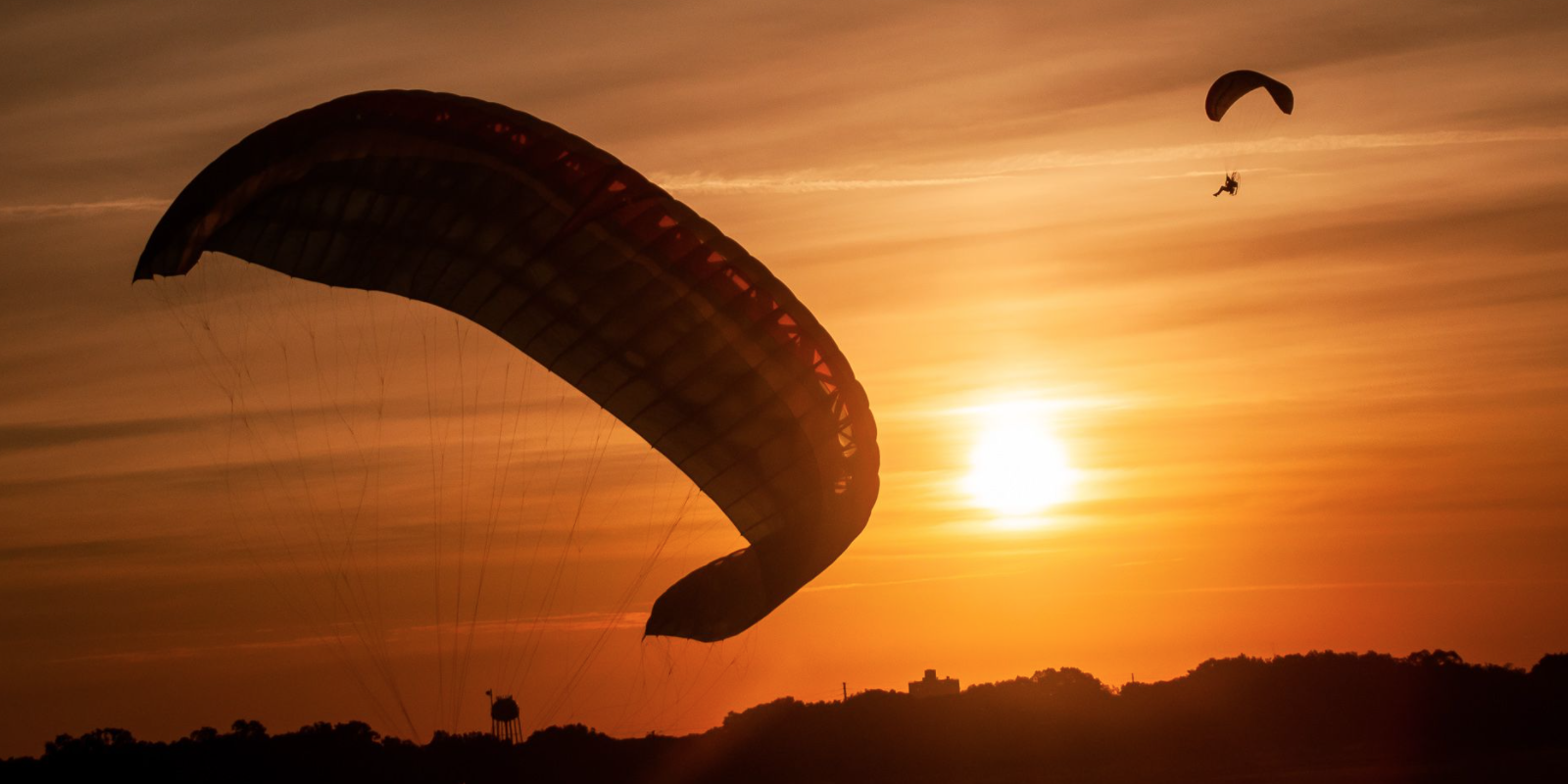Powered Paragliding (PPG) | The Ultimate Guide
Normal people drive a car to work. Cool people ride a bike. Crazy awesome people launch a Powered Paraglider from their back yard and land in their office parking lot.
If you love the feeling of the wind in your hair (or beard), if heights give you an adrenaline kick, or if you need a new, epic hobby, Powered Paragliding just might be the sport for you!
Powered Paragliding, also known as Paramotoring or PPG, is a surprisingly affordable activity that is easy to learn and an absolute blast to experience. Technically, it is a form of “ultralight aviation,” which simply means it has 1 or 2 seats, is lightweight, and is a fixed-wing aircraft.
Groove Life is more than a business. We exist to serve people, inspire adventure, and reflect God. And for us, that starts in the great outdoors! We are committed to working hard to plan in advance and share that information so YOU can experience these fantastic adventures for yourself!
Needless to say, Powered Paragliding is an adventure that we just could not pass up. The Groove Life Adventure Team took on Powered Paragliding and had so much fun that we decided you need to be able to try it, too.
In this guide you will learn all there is to know about Powered Paragliding and then some! It will set you up for success and lead you to the resources you need to find a PPG instructor, get certified in PPG, equip yourself with the right gear, and fly safely. This guide will also give you the confidence and inspiration you need to get out there and take to the skies!
Well, what are you waiting for? Grab yourself a cup of strong, black coffee and let’s get started on the Powered Paragliding adventure of a lifetime!
Click here to view the Groove Life adventure on YouTube.
Powered Paragliding Ultimate Guide
- History of Powered Paragliding
- What is Powered Paragliding?
- Anatomy of a PPG Unit
- How Dangerous is Powered Paragliding?
- Who Can Go Powered Paragliding?
- What are the Options for Powered Paragliding?
- What Do I Need to Go Powered Paragliding?
- Comparison of PPG Companies
- Is a Pilot License Required to fly a PPG?
- Do I Need Professional Training?
- PPG Training Schools and Where to Find Them
- Where to go Powered Paragliding
- Conclusion
- Appendix
History of Powered Paragliding
So, you’ve always wanted to fly?
Turns out, so has the rest of the world, since the beginning of time! All you have to do is crack open a dusty tome of Ancient Greece and you’ll find the mythical legend of Pegasus, the winged horse who could fly through the heavens and now has a home in the sky as a constellation. Later, in the 1400s, Leonardo da Vinci sketched out an Ornithopter that allegedly could take mankind to the skies. His plan was actually used in part to design the helicopter!
From there, history sees a series of gliders - most famous of which is the Wright brothers’ Glider Kite that was designed in 1900. In 1905, the Wright brothers’ engine powered “Flyer” took flight successfully… man had finally entered the skies.
In the 1970’s, photos show people testing repaired parachutes by “slope soaring” which is the whole idea of paragliding. This developed into hang gliders and, over the years, the structure was enhanced to allow more air time for distance traveled and the paraglider wing was born. This method of flight was simply a glider until La Mouette of France added power to the paraglider wings in an effort to make the flight last longer. This powered machine was called a paramotor. In 2006, Csaba Lemak created the first electric PPG and took it for a spin! However, your typical PPG flies on a mixture of gas and oil.
Over the years, the simple parachute has evolved into the powered paragliders that so many people love today, and we get to benefit from it! Today, there are thousands of powered paragliders all around the world and it has become a popular sport for those who long to reach for the skies.
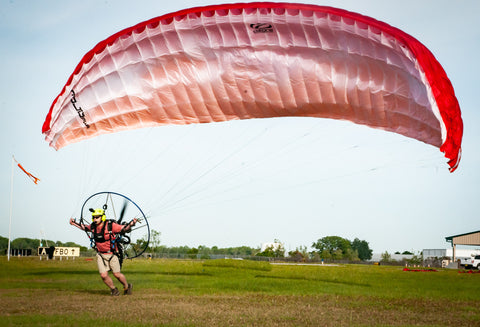
What is Powered Paragliding?
Powered Paragliding or PPG is an absolutely fantastic way to fly and the best part is, you don’t need a pilots license to do it! There are a few things you do need to know before you take flight powered paragliding but we will get to those a little later!
Basically, Powered Paragliding is similar to skydiving but the momentum remains and you are able to cruise through the skies like a hot air balloon… just a lot faster! In order to start, strap on the motor as a backpack and set off on a short run (hence the term “foot-launched”) to let the wind catch your large wing, then rise up into the air as the motor powers a large fan on your back to propel you through the air! It’s as simple as that!
What makes PPG so special is it is possible for just about anyone and really doesn’t cost that much to learn! It is one of the simplest and lightest forms of human flight, so it’s easy to store and not difficult to transport. Plus, with the right training and used with caution, it is a safe sport as well.
Comparatively safe, inexpensive, convenient, and easy! What’s not to love?
Anatomy of a PPG Unit
A PPG Unit is a fairly simple device when you compare it to something as crazy as an airplane, or helicopter. We were amazed at how simple this ultralight aviation device truly is. Looking at the basics, it is made up of one large inflatable wing, lots of connecting lines and brake lines, handles called “brake toggles,” a harness, a reserve parachute, and the motor. The motor itself consists of a cage hoop, propeller, and gas tank.
Each of these has an important purpose and is essential to the success of the unit.
The wing.
The wing of a powered paraglider is inflatable and keeps the paramotor above ground. Wings are rated by their ability to recover from collapses, so you’re going to want to invest in the best wing possible. When you’re choosing a wing, you’ll want to look at are the “glide ratio” - how far it will glide when the motor is off - and the “EN” certification - which is divided into class A, B, C, or D, and lets you know the level of passive safety. Those who are new to PPG should start with a class EN-A wing.
The lines.
The PPG Unit has a lot of lines and each of them has a very specific purpose. As you go through your training, you will learn how to use the lines to direct your flight!
The lines are broken down into A-lines, B-lines, C-lines, and Brake lines.
The toggles.
The toggles are small handles that are attached to the brake lines. They help you to control the direction and height of the paramotor.
The motor.
The motor of a PPG is basically a large fan that is strapped onto your back and keeps you moving forward. This motor is designed to be light yet powerful.
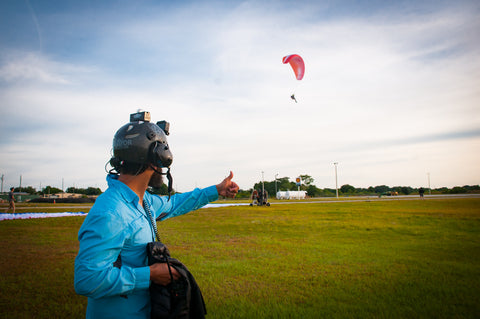
How dangerous is Powered Paragliding?
You’re flying 10,000 feet above the ground with a motor strapped to your back and a “sail” of sorts fluttering above your head, attached by some small lines. That doesn’t sound very safe, does it?
That is exactly what we were thinking when we showed up for training on the first day! In typical Groove style… we took the challenge on without hesitation.
As crazy as it may sound, Powered Paragliding is one of the safest sports out there and is actually far safer than driving a car. That being said, you are always taking a risk when you fly through the air, and it’s important to be extremely careful and keep a few things in mind as you plan your adventure. It only takes one small mistake to cause some major damage. Be careful… but have fun, too!
Here are some tips to keep in mind when you’re getting ready to head out on your PPG:
1. Get proper training.
Powered Paragliding is relatively safe… when you know what you’re doing! We cannot overemphasize the importance of making sure you train with a qualified, USPPA certified instructor. We were careful to select an instructor we trusted completely - Eric Farewell from Aviator PPG, and he did an amazing job. He taught us how to fly safely, and gave us advice on the gear to buy. No matter the cost, an investment in proper training is one need to make if you are going to fly safely.
2. Make sure your machine is up to date and running effectively.
Do not take any chances with your equipment. Make sure you have routine checks on your wing and all other equipment. If you have a gut feeling or something seems to be off, do not fly. Get your equipment checked regularly. Treat your PPG Unit with the respect and caution you would use if it was a commercial airplane full of people. It’s always better to be safe.
3. Triple check the weather.
Certain weather conditions can make flying a PPG impossible or dangerous. We were very cautious during training… we didn’t want to learn the hard way how dangerous it can be to fly in rain or wind! Make sure you always check the weather and only fly when there is zero chance of rain and storms and only wind that is under 10mph. If you are unsure of the wind at a higher altitude, we recommend that you use a resource like Wind Alert to make sure you are clear to fly.
4. Try not to fly low. Watch for power lines. Know your route.
You’d think that it’s safer to fly low in a PPG, but that actually isn’t true! When you fly low, you run the risk of encountering obstructions like power lines - which are especially dangerous because they are hard to see - or trees, hills, and cliffs. Make sure you look over your route before you fly so you won’t be surprised by an unforeseen power line or other obstruction.
5. Never ever take risks
Never let your guard down. It’s just not worth it. Make sure you are always checking every part of your machine before you set out and, if you have a gut feeling about a potential safety hazard, choose to stay safe. We’re taking the risk of sounding like your super-protective grandma here… but it’s always better to be safe than sorry.
6. Guard against “camera courage.”
Most adventurers know that when you’re in front of the camera or a crowd, you get a little extra gutsy! This can be a thrilling feeling, but just make sure you’re guarded against the temptation to “throw caution to the wind!”
7. Stay away from water.
The combination of a motor on your back, long lines, and a large wing can contribute to a dangerous situation in water, even if it’s only a foot deep. Stay on the safe side - view the water from the side and avoid crossing it for any reason.
Keep these tips in mind as you navigate the skies, and you will be set up well to master the PPG without any fear! After all, it is one of the safest sports you can participate in as long as you have a healthy respect for the wind and other elements.
Who can go Powered Paragliding?
If you have breath in your lungs and a sense of adventure, you’re qualified to set sail with a powered paraglider! One of the most fantastic things about PPG is that just about anyone can do it without much hesitation! That being said, there are a few questions you might be asking as you consider going PPG:
Do I have to be a certain age?
Although there are no legal age restrictions for PPG operators, most training programs won’t accept any students under the age of 14. This is for the safety of the individual because as people grow older they tend to be more cautious, which is a very important element of PPG safety.
As for a maximum age… it doesn’t exist! PPG is relatively gentle on your body so that is nothing to worry about!
Do I need to be physically fit?
You don’t have to be a Crossfit trainer to be fit for PPG, but you will need to be able to do a small amount of jogging and jumping. Each flight requires a short run of 10-50 feet. If you are not physically able to run this distance at this time, it would be a good idea to start jogging a little, stretching or going on brisk walks to prepare for training.
You also should be ready to jump a few feet if needed.
Do I need a license to fly?
You sure don’t! This is a huge plus for this activity! BUT we do highly recommend that you make sure you have a really good instructor! Owning all the right gear is fantastic but you need to have a knowledgeable, trustworthy instructor to succeed in PPG. We are including a list of some of our favorite PPG instructors later on, so keep reading!
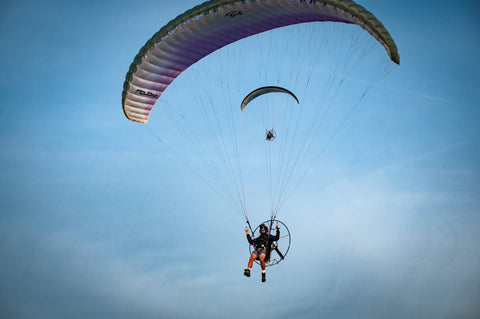
What are the options for PPG?
When you’re picking out gear for your first ever PPG, make sure you know the difference between all of the ultralight aviation devices that are out there! A Powered Paraglider is also known as a Paramotor.
It is not: a non-powered paraglider, a powered parachute, a parachute, a hang glider… or a jet!
In an earlier section, we went over the different parts of a PPG unit. In this section, we are going to talk about the different types of Paramotors that you can buy!
Standard Powered Paraglider
The standard Powered Paraglider includes a wing, the motor strapped to the back in the shape of a large fan, and the harness! This is the type of Paramotor that the Groove Life Adventure Team used when they went on a paragliding adventure earlier this year!
Paramotor/Paraglider Trike
You may have seen these crazy contraptions flying around, looking a lot like a gocart with wings… well this is a paraglider wing and fan motor attached to a trike! While the Groove team didn’t try this one out, it is an equally fun way to hit the sky!
Electric Paramotor
One of the newest options for PPG enthusiasts, the electric paramotor doesn’t require gas. Instead, it runs on electricity! All you have to do is charge your PPG up and take it for a spin!
So now that you know what kind of machine you’re dealing with… what do you need to go Powered Paragliding?
What do I need to go Powered Paragliding?
Powered Paragliding is so fun because it requires very little equipment! You don’t need a bird, a plane, or Batman to fly through the air! All you need is a wing, the big backpack fan we call “the motor,” and the rest is simple and common sense!
Here’s our condensed list of things you need to PPG.
Buy (quality) flying gear
Simple rule: Don’t buy it unless you can see the owner fly it in person.
Explanation: Don’t gamble with your safety. Buy quality gear that is made to last. If you want our advice, we recommend that you ask your instructor for an inside opinion on where to buy equipment. They will likely have the best advice and be able to point you to a trustworthy seller in your area.
Speaking of trainers...
Invest in excellent training
If you take one thing from this guide… let it be this! Make sure you receive training from the best because this will set you up for success! PPG, if approached the right way, could be something you enjoy for a whole lifetime! Our trainer was Eric Farewell from Aviator PPG and we were so impressed with his knowledge, experience, and commitment to safety. Quality training can cost around $3,000 dollars but that is an investment that is worthwhile!
Always wear a helmet
You never know what a PPG flight might bring, from bird droppings to an unexpectedly quick landing, so it’s always good to be prepared! Make sure you always pack and wear a helmet on your PPG adventures.
Wear the right clothing.
Paramotoring, just like any sport, is more fun when you are comfortable! Pack along appropriate clothes for the weather you are facing. Remember, it gets colder the higher you go, and you’ll be facing a breeze when flying through the air!
It would be best for you to wear boots that support your ankles in case you experience a harder landing. You’ll want to bring a pair of sunglasses or safety glasses, as well as ear protection. Choose jeans over shorts, even if it is hot, to protect your legs in case of a fall or contact with trees (worst case scenario).
Bring a 2-way radio or cellphone.
It’s always wise to make sure you have a way to contact someone in case you get lost or something happens to prevent you from traveling home as expected. Many PPG pilots bring a 2-way radio, but a cellphone works just as well.
Carry a reserve parachute.
In case of emergency, you’ll be glad you had a reserve parachute! Make sure you don’t forget this when you’re packing your gear for a day in the clouds!
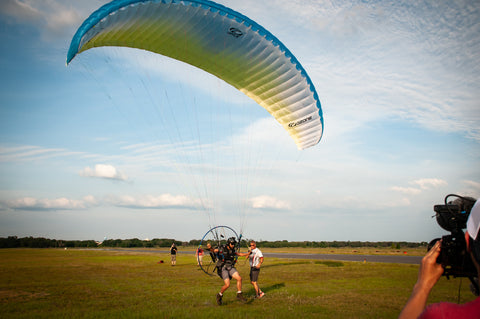
Comparison of PPG Companies
You know what you need to fly… now you need to decide where to buy it!
There are so many different PPG Companies out there, and each of them offer a variety of options that all can seem so enticing! It can be hard to know which companies offer the best options for what YOU need, so we are going to go in depth with a few companies so you are equipped to do the research!
Before we get started, it’s worth mentioning that your flight instructor is a great person to ask about this option. They can recommend a company and PPG model based on personal experience and also based on what you trained with. Just like cars, different models of Paramotors have a different feel, so it’s usually a good idea to stick with something similar to the one you trained with!
One more thing to consider: price does not always equal quality. Sometimes the trustiest motors come with a lower price tag because you’re paying for what matters. And what matters when you’re soaring through the sky is durability and quality.
That being said, here are some of the companies we found that are reliable and pretty darn awesome.
ParaJet
Parajet is a tried and true company with a 19-year history. This is the company our trainers recommended to us because they use ParaJet paramotors on a daily basis. The company was founded in the UK and they are constantly thinking outside the box and are builders the world’s first practical flying car!
ParaJet is the official supplier for Red Bull Airforce and partnered with adventurer Bear Grylls to design the BG Paramotor. Their Paramotors are durable and safe, with a variety of options for the newer pilots as well as the experienced. ParaJet Paramotors range from $4,000-$10,000 for a motor.
Fly Products
Fly Products Paramotors are available worldwide, and the US dealer our favorite Aviator PPG! These Paramotors are proven to be high quality and pretty cool looking as well, sure to be a win.
Air Conception
Air Conception dealers are located all over the US so you can actually buy them in person, which is a super nice feature! These PPG Units range from $6,000-$8,500 each which includes shipping if you do end up purchasing it online. They also offer a pretty nifty travel bag which is ideal to use if you end up traveling to your flying destination by plane!
Black Hawk Paramotor
Not only does Blackhawk Paramotor have an awesome name, but they offer the whole spectrum of gear AND a 7-day training course at their Valley Springs, California location! Their complete Paramotor gear packages range between around $7,500-$17,000, depending on what you are looking for.
Nirvana Paramotors
According to Groove Life founder Peter’s dad, who is pretty much a PPG expert, Nirvana products are “the Cadillac of Paramotors.” While these Paramotors are very well built, they can be very expensive in the USA. Nirvana Paramotors take safety very seriously and their units are tested according to the standards of many different countries.
That sums up our list but, like we said before, your flight instructor is a great resource to help you as you choose which Paramotor is a good fit for you because they are able to direct you to a safe option that is in your price range and a close fit with the one you used to train.
Is a Pilot License Required to Fly a PPG?
Nope! This is one of the most enticing facts about PPG - you can literally float through the air like a cloud, no pilot license necessary! Unbelievable, right?
That being said, it’s important to make sure you are well trained and ready to navigate your Paramotor before you set out. What you need is professional training… and we’re about to get to that.
Do I Need Professional Training?
Our answer is absolutely. You will never regret investing in quality training. Although this can be pricey, it’s a small price to pay for the unfathomable reward of heading into your PPG experience fully equipped and ready for whatever may come your way.
Here are a few things that you will gain from your PPG instructor.
How to choose a PPG instructor.
Here’s what you should not do:
- Don’t ask your buddy who has a powered paraglider if he can take you for a spin and teach you the basics.
- Don’t hop on Craigslist and message the first guy you find advertising cheap lessons.
- Don’t buy a glider and teach yourself. Don’t do it… trust us.
We had the best PPG experience imaginable, and it’s 150% due to our incredible PPG instructor, Eric Farewell.
We want you to have the same fantastic experience, so we put together a list of things to look for in a PPG instructor.
Your PPG instructor should be...
Certified
It’s best to find an instructor that is a USPPA Certified Instructor. While this is not necessary, it guarantees that this person has been approved by a credible source and is definitely qualified to teach you!
Experienced
Just because someone has flown a PPG before and has one stuffed in a corner of his basement does NOT mean he or she can teach you effectively! Make sure you choose a PPG instructor that has years of experience under his belt and has been an instructor for years.
Personable
As you can imagine, learning how to fly a paramotor requires intense focus! Equally important, it also requires a relaxed, teachable spirit! Make sure you choose an instructor that is easy to talk to and one that you feel comfortable around because you are going to be spending a lot of time with this person and trusting them with your life! They can make or break your attitude as you learn, so choose wisely!
Cautious
Learning to fly PPG can be very dangerous, so you want to make sure that your instructor will take every precaution. Choose an instructor who will take everything into account including wind, weather, and check every small detail before taking flight. It is important, not only that you learn HOW to fly, but also that you learn how to make the decision whether or not it is a good time to fly.
That’s it! If your instructor is certified, experienced, personable, and cautious, you are going to have a fantastic experience learning to fly a paramotor! So… where do you find an instructor like that? Our answer is… at a PPG Training School!
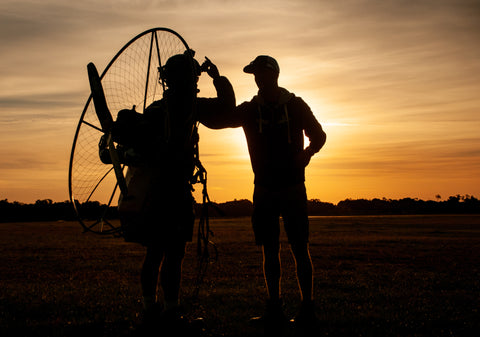
PPG Training Schools and Where to Find Them
So you thought you only needed to find gear and an instructor… turns out there’s a lot more to think about when you’re learning to fly a powered paraglider! Take it from us… you’d be best served to attend a training school! At Aviator Paramotor in Lake Wales Florida, we were able to take several days and train with the incredibly skilled Eric Farewell in several stages that worked us up to the point that we leapt into the sky with confidence!
It can be a little challenging trying to decide which school to choose.
Here’s our experienced advice. *wink*
Pick a school with certified instructors.
This probably sounds a little repetitive but the facts remain… the best schools are the ones with the best instructors. Make sure you are checking into the quality of the school, but also the experience of the instructors as well. After all, they are the ones who will be dedicating hours to making sure your PPG experience is fantastic!
Check out the system.
Training is all about the process. The program we chose at Aviator Paramotor offers in-depth training with the most up-to-date tactics. We were able to start by simply “kiting” which basically means putting the harness on backwards, attaching a wing, and practicing directing the wing with the toggles. The next step was towing, where we were able to actually fly, while attached to a line for safety. That way, if anything went wrong, we could easily be brought safely down to the ground. The final step was… you guessed it… taking flight solo! And boy, was it worth it.
Read the reviews.
As you’re putting in your research on the training schools out there, make sure you read the reviews! A fancy website and cool photos are fun to look at, but it’s how people feel at the business that sets a place apart. Our training program had fantastic reviews, which played into the decision to go with them in the end.
Use every resource.
When in doubt, take a look at the USPPA training school database to find local quality PPG training schools! This is a fantastic resource for finding a school, a trainer, and more information about PPG safety and regulations!
So, now that you know how to get the best training on how to fly… it’s time to talk about where!
Where to go PPG
You can fly your PPG absolutely anywhere, unless there are flight restrictions or a high volume of air traffic! Your PPG will be small enough to fit in the back of your car, so you can take it everywhere!
When you’re deciding where to fly your PPG, you’ll need to make sure your location is suitable for flying! Here are a few things to look for when planning to go Powered Paragliding:
Good weather
You may not think weather has a lot to do with location, but that actually isn’t true! The terrain you choose for your PPG flight can drastically impact the “turbulence” of your flight! For example, there can be strong wind gusts in the mountains that go straight up and straight down, because the wind patterns after the cliffs that surround it. Make sure you keep this in mind and research wind patterns and weather before hitting the mountains for a flight.
A good “take off zone”
You’ll need a small runway for your PPG flight! Make sure you have enough room to lay out your wing, get a running start for at least 50 feet, and a good amount of space after that to act as a bumper in case you don’t end up taking off.
Always watch for landing spaces
Even though Powered Paragliding is totally relaxing - you could kick back and enjoy a glass of lemonade from the sky… and there’s nobody to bother you - it’s important to stay vigilant. As in any extreme sport, make sure you’re always looking for a space that you could land if needed.
Keep an eye out for trees and power lines
Before you start your flight in a new area, take a look around and note the location of power lines and trees! Make sure you have plenty of room ahead of you to launch without hitting any obstructions if the flight were to start out low.
Conclusion
We hope this complete ultimate guide to powered paragliding was helpful for you as you sort through the many options for PPG! If you’re ready to hit the skies, be sure to snap a few photos of your PPG adventures and tag us in them on Instagram!
Take it from us, when you fly a Paramotor, it’s just as simple as this: “you’re sitting in a lawn chair in the sky.” Now that’s an experience anyone could get into.
Keep Groovin’!
Appendix
United States Powered Paragliding Association. Powered Paragliding Resources. About Powered Paragliding.
Black Hawk Paramotor. Frequently Asked Questions.
Federal Aviation Administration. Regulations and Guidelines.
Satora. Air Law.
National Aeronautics and Space Administration. How Did We Learn to Fly Like the Birds?
Cross Country. David Barish, the Forgotten Father of Paragliding.
Athnet Get Recruited. The History of Paragliding.
Parajet. What is Paramotoring?
Southwest Airsports. Powered paragliding (PPG) equipment – typical setup.
Paramotor Prodigy. The Official Paramotor Wing Guide – How to Choose a Paramotor Wing
